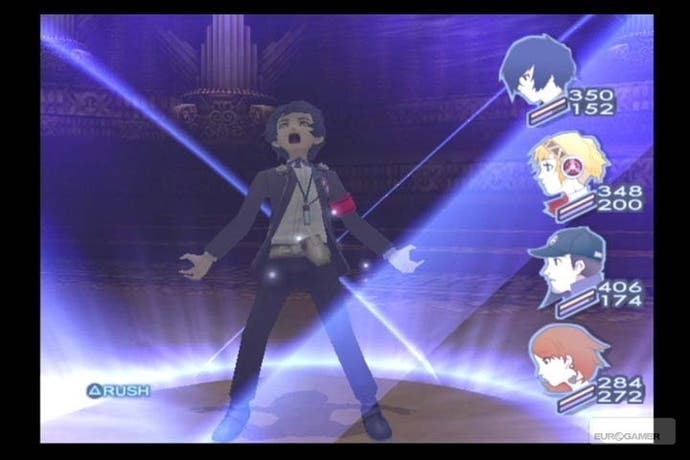Shin Megami Tensei: Persona 3
Shoot yourself in the head.
This actually makes quite a lot of sense, because the game heaps much of its complexity onto that one character. While every other character in the game can use one Persona and one class of weapons, the protagonist's special ability is that he can use multiple Persona, switching between them each turn as needed. This allows you to adapt to the elemental weaknesses of your foe - essential here, because only by striking each enemy in its weak spot can you earn additional battle turns and powerful group attacks, both of which you need to master as you progress.
On the plus side, only managing one character means that you can treat the others effectively as support - their actions are fairly predictable and can be integrated into your own strategy easily, and you don't have to learn a host of confusing spell names and summon types for every character, which is definitely a bonus. Unfortunately, the single-character focus also brings with it some interface problems. It's especially annoying that you have to talk to each team member separately in order to upgrade their equipment, and can't see what they're using when you're at an equipment store.
Despite such niggles, however, the dungeon-crawling sections manage to remain surprisingly fresh and interesting for a very long time - not something we're caught saying very often about games which randomly generate their dungeons. Battles strike a fine balance between being very fast and being very tactical, and the game is clever enough to make weak enemies run away from you - so you won't face anything that's so far below your level as to be worthless.
The superego

So, what's the connection between that and the Grange Hill stuff? Well, there are two connections. The first and most simple is the game mechanic you use to create new Personas. You acquire Personas in a card shuffle at the end of most successful battles, but these are simple and often quite low-level Personas - if you want to start really dishing out some pain, you'll need to combine those cards to create new, merged Personas.
The system for doing this is well-considered and intuitive, giving you all the information you need right from the outset - so you won't be taking shots in the dark and throwing away perfectly good cards on rubbish combinations. However, there's another key influence here. Each Persona has a certain "type", and that type is connected to a Social Link you've made in the game - a connection with a person or group of people. The stronger the Social Link, the stronger the Persona you can create of that type. So, yes, what we've just described is a system where you go through a bright, happy school environment making friends and relationships - purely so that you can then feed on the strength of those relationships when you need to summon up demons from your own subconscious.
This is the other key link between Persona 3's two distinct games, and the element which lifts it from greatness to magnificence. Persona 3 is a little bit wrong. It knows it's wrong, and it revels in it. Summoning those Personas we mentioned? That's accomplished by taking out a gun and shooting yourself in the head. Oh, it's dressed up - it's not a gun, it's an "Evoker" - but ultimately the animation, each time you invoke a Persona, is of a young teenager placing a gun to their skull and blowing their own brains out. Some of the earlier (beautifully animated and stylised) cut-scenes show extended, harrowing scenes of kids summoning up the courage to do just that.

It doesn't stop there. Vivid, nightmarish dreamscapes where those without Persona abilities are frozen in coffins that litter the streets are ten a penny. Humans caught by the Shadows gradually start to litter the town, essentially brain-dead and drooling on street corners. Teenage sex, drugs and drinking are all on the menu, often overtly.
This is a game that builds up a castle of lovable cuteness, supported by a bouncy and eminently catchy Japanese pop and hip-hop soundtrack, and then takes delight in tearing the whole edifice down with bloodied claws. It's a wonderful marriage of light and dark - one which bounces from one theme to the other until your head spins - and you love every minute.
Surprisingly, too, it looks great. Even to our next-gen trained eyes, it has a lovely sense of style - supported by a wise decision to use 3D characters and environments for battle and navigation, but to fall back on lovely 2D artwork to convey expressions and emotions. (PS3 owners take note, it looks especially gorgeous when upscaled.) The dungeon levels do get rather repetitive, admittedly, but some very original monster and Persona designs definitely help to lift the visuals on that side of the game.
Granted, there will always be those for whom story-led gaming and turn-based battles are a complete turn-off, and for those people, Persona 3 is unlikely to be a Road to Damascus experience. For the rest of us, though, this is one of the finest RPGs on the PS2 - and that, in itself, is a huge accolade. If your PS2 has been gathering dust, now is definitely time to bring out the old warhorse - and if this is its last gallop, then at least it's also one of its finest.

